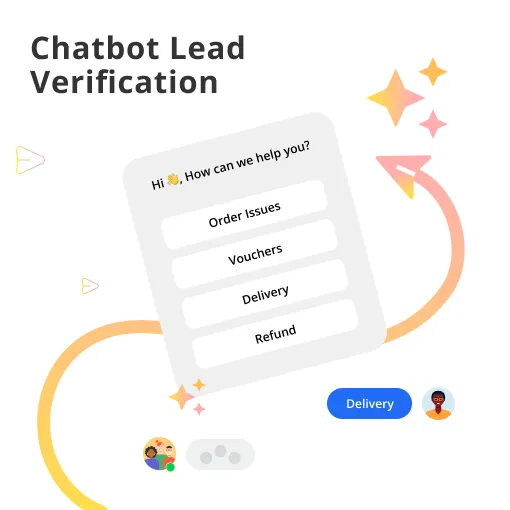What is Chatbot Lead Verification?

Chatbot lead verification refers to verifying the authenticity and accuracy of leads captured through chatbots. It involves using various methods and technologies to ensure that the leads are genuine and not fraudulent or inaccurate. Chatbot lead verification has become increasingly important as more businesses adopt chatbots to engage with customers.
Why Chatbot Lead Verification Matters?
1. Preventing Spam and Fraudulent Activities

One of the main reasons why chatbot lead verification matters is to prevent spam and fraudulent activities. Chatbots attract spam and fraudulent activities, which can result in inaccurate leads and waste of resources. Chatbot lead verification can help identify and prevent such activities, ensuring that only genuine leads are captured.
2. Ensuring Data Accuracy
Another reason why chatbot lead verification matters is to ensure data accuracy. The accuracy of lead data is crucial for businesses to make informed decisions and take appropriate actions. Chatbot lead verification helps ensure that the lead data captured is accurate and reliable.
3. Saving Time and Resources
Chatbot lead verification can also save time and resources for businesses. Manual verification of leads can be time-consuming and expensive. Chatbot lead verification automates the process, saving time and resources for businesses.
4. Improving Customer Experience
Chatbot lead verification can also improve customer experience. With accurate and reliable lead data, businesses can provide personalized and relevant content to their customers, resulting in a better customer experience.
Why use Chatbots for Lead Verification?
1. 24/7 Availability
Chatbots can provide 24/7 availability, allowing businesses to respond to leads at any time of day or night. This is particularly useful for businesses with a global customer base, as leads may come from different time zones. With chatbots, businesses can ensure that leads are verified quickly and efficiently, improving the overall sales process.
2. Quick Response Times
Chatbots can provide instant responses to lead inquiries, improving response times and increasing the chances of closing a sale. With quick response times, businesses can ensure that leads are engaged and interested in the product or service, increasing the likelihood of conversion.
3. Consistent Verification Process
Chatbots can provide a consistent lead verification process, ensuring that all leads are verified similarly. By using pre-defined questions and responses, chatbots can ensure that the verification process is consistent and accurate, improving the overall quality of leads.
4. Cost-Effective
Chatbots are a cost-effective way to verify leads, reducing the need for human agents and lowering costs. This is particularly useful for businesses with a high volume of leads, as chatbots can handle many conversations simultaneously.
5. Data Collection
Chatbots can collect user data and provide insights that can be used to improve lead verification. By analyzing user data, businesses can identify trends, common issues, and areas for improvement. This allows businesses to optimize their lead verification process and improve the overall quality of leads.
6. Improved Customer Experience
Chatbots provide a seamless and efficient customer experience, improving customer satisfaction and increasing the likelihood of repeat business. Using chatbots for lead verification, businesses can ensure that potential leads are engaged and interested in the product or service, improving the overall customer experience.
7. Improved Lead Quality
Chatbots can improve the overall quality of leads by ensuring that only genuine and interested leads are verified. Using pre-defined questions and responses, chatbots can identify potential red flags or disinterest, ensuring that only high-quality leads are verified.
Who can Benefit from Chatbot Lead Verification?
1. Small Businesses
Chatbot lead verification can help prioritize high-quality leads for small businesses with limited resources without breaking the bank.
2. Large Enterprises
Enterprise-level businesses can use chatbot lead verification to streamline and automate the lead qualification process across multiple marketing channels and campaigns.
3. Digital Marketing Agencies
Agencies can incorporate chatbot lead verification into their clients' marketing strategies, improving campaign performance and generating better client results.
When to Implement Chatbot Lead Verification?
1. High Volume of Leads
If your business generates a high volume of leads, it can be challenging to verify the accuracy of customer information manually. Chatbots can handle multiple conversations at once, making lead verification faster and more efficient.
2. Human Error
Manual lead verification is prone to human error, which can result in inaccurate data and lost opportunities. Chatbots are programmed to follow a specific set of rules, ensuring that lead verification is consistent and accurate.
3. Limited Resources
If your business has limited resources, it can be challenging to allocate time and resources to lead verification. Chatbots can handle lead verification without any additional resources, freeing up human agents to handle more complex inquiries.
4. Improved Lead Quality
Chatbot lead verification can improve the quality of your leads by verifying the accuracy of customer information. This can help businesses avoid wasted resources on inaccurate or incomplete leads.
5. Faster Response Times
Chatbots can verify lead information quickly, reducing response times and improving the overall customer experience. This can help businesses build customer loyalty and increase sales.
6. Streamlined Lead Qualification
Chatbots can streamline the lead qualification process by asking relevant questions and verifying customer information. This can help businesses prioritize leads and allocate resources more efficiently.
7. Cost-Effective
Chatbots are cost-effective compared to manual lead verification. By automating the lead verification process, businesses can save time and resources while improving the overall quality of leads.
What are the key components of Chatbot Lead Verification?
1. Data Collection
Chatbots can gather essential user information, like email addresses, phone numbers, and preferences, to help assess lead quality.
2. Data Validation
Once the data is collected, chatbots can validate the information by cross-referencing it with other data sources, ensuring that the leads are genuine and accurate.
3. Lead Scoring
Chatbots can also assign a score to each lead based on predefined criteria, helping you prioritize your marketing and sales efforts on the most promising prospects.
How to set up Chatbot Lead Verification?
1. Choosing the Right Chatbot Builder
To set up chatbot lead verification, select a chatbot builder offering lead verification features and integrating with your existing marketing tools.
2. Configuring Lead Verification Parameters
Define the lead validation and scoring criteria, such as user behavior, source, and demographic information. Remember, you want to focus on quality, not just quantity!
3. Designing a User-Friendly Verification Process
Create a smooth, engaging verification experience for users by crafting conversational flows that guide them through the process without feeling like a tedious interrogation.
Types of Lead Verification Methods Used by Chatbots
1. Form Verification
Form verification involves verifying the information provided by the user in a form. Chatbots can automatically check the form for errors or missing information and prompt the user to provide the required information.
2. Email Verification
Email verification involves verifying the user's email address. Chatbots can send a verification email to the user's email address and prompt them to click on a verification link.
3. Phone Verification
Phone verification involves verifying the user's phone number. Chatbots can send a verification code via SMS or voice call and prompt the user to enter the code to verify their phone number.
4. Social Media Verification
Social media verification involves verifying the user's social media account. Chatbots can prompt the user to connect their social media account, and then verify the account using social media APIs.
5. IP Address Verification
IP address verification involves verifying the user's location and IP address. Chatbots can use geolocation APIs to verify the user's location and IP address.
6. Image Verification
Image verification involves verifying the user's identity using an image. Chatbots can prompt the user to take a selfie or upload a photo of their ID for verification purposes.
7. Signature Verification
Signature verification involves verifying the user's signature. Chatbots can prompt the user to sign their name using a stylus or touch screen, and then verify the signature using signature recognition software.
Chatbot Lead Verification with CRM and Marketing Automation Tools
1. CRM Integration
Connecting your chatbot lead verification system with your CRM helps you manage and track verified leads more effectively, ensuring seamless data sharing and improved lead management.
2. Marketing Automation Integration
Integrating your chatbot with marketing automation tools allows you to create personalized, targeted campaigns for verified leads, improving conversion rates, and customer engagement.
Best Practices for Chatbot Lead Verification
1. Balancing User Experience and Verification Requirements
While verifying leads is essential, don't forget about user experience! Make the verification process as frictionless as possible and enjoyable for users. Remember, a happy user is more likely to become a loyal customer.
2. Ensuring Data Privacy and Security
Ensure your chatbot complies with data privacy regulations and follows best practices for secure data handling. Trust is key in building a strong relationship with your leads.
3. Regularly Monitoring and Improving Verification Processes
Continuously evaluate your chatbot's lead verification performance and make necessary adjustments to improve its effectiveness. Stay on top of your game, and your chatbot will thank you!
Measuring the Success of Chatbot Lead Verification
1. Key Performance Indicators (KPIs)
Track metrics such as lead quality, conversion rates, and user satisfaction to measure the success of your chatbot lead verification efforts. Remember, data is your best friend!
2. Analytics and Reporting
Utilize your chatbot builder's analytics tools to gather insights on your chatbot's performance and identify areas for improvement.
3. Continuous Optimization
Based on the data and insights gathered, refine your chatbot's lead verification process to optimize its performance and maximize its impact on your business.
